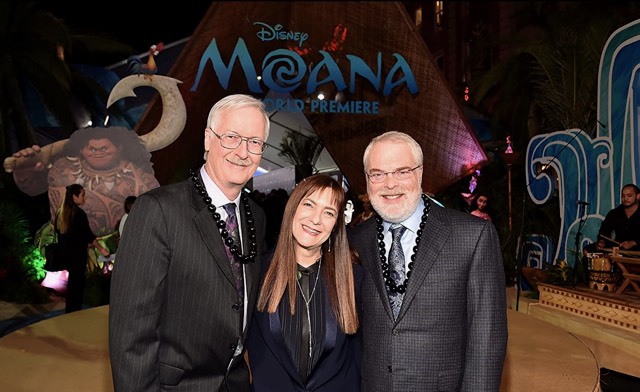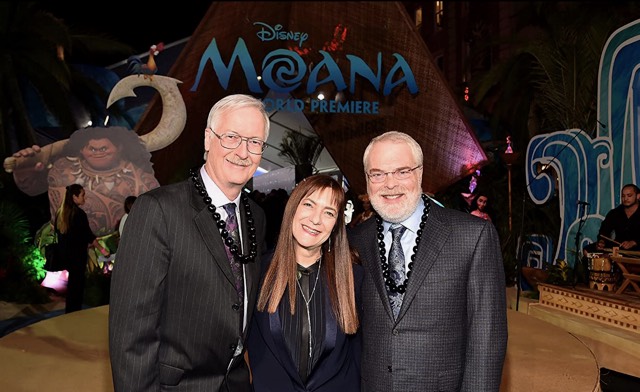As the 8th anniversary of Disney’s MOANA approaches, HIFF is honored to host directing duo Ron Clements and John Musker, along with producer Osnat Shurer.
Ron and John have directed beloved Disney films such as THE LITTLE MERMAID, ALADDIN, HERCULES, and THE PRINCESS AND THE FROG. They worked with some of Walt Disney’s core animators (colloquially known as the “Nine Old Men”) during the early days of their careers, and witnessed the gradual shift from traditional 2D animation to CG animation at Disney.
Osnat, currently the Co-Chief Creative Officer at Baobab Studios, has produced RAYA AND THE LAST DRAGON, Pixar shorts (BOUNDIN’, ONE MAN BAND, LIFTED), documentaries, and interactive shows at museums. She was also instrumental in the creation of the Oceanic Story Trust and Southeast Asia Story Trust at Disney.
HIFF44 Programming Associate Kristy Miki Munakata had the opportunity to ask Ron, John, and Osnat a few questions about their careers:

Ron and John, you’ve directed beloved Disney films such as THE LITTLE MERMAID, ALADDIN, and THE PRINCESS AND THE FROG. What was the shift from traditional animation to CG animation like for both of you?
Ron: “It was exciting & a little scary to direct our first digital film with MOANA. We even had to take classes to learn what we’d be dealing with. The early part of the process—story, script, visual development, songs, storyboarding, casting & recording actors is pretty much the same. But things like layout (cinematography), character design, animation, effects, color & lighting are very different. Everything is dimensional. The characters have to be built & rigged with 3-D models. All the background elements, including every tree & leaf are built dimensionally. There are so many iterations. You have to approve individual, partial elements without knowing exactly how it’s all going to fit together. You have to trust people more. The camera can move just like in a live action film. And there is a process called tech animation (the movement of hair, clothes, ropes & sails) that doesn’t even exist in hand drawn. And the possibilities with lighting are astounding. Finally, in effects we could create characters like a living ocean & a lava monster in a way that would be virtually impossible in hand drawn.”
John: “We learned that the production path for CG films is quite different in some ways than hand drawn. Certainly both types begin with stories and storyboarding and visual exploration of characters and settings.
But hand drawn follows a more linear production path. You move from storyboards to layouts (placing the camera, establishing where the cuts come, the design of the settings, etc.,) then on to rough animation, cleaned up animation, effects animation, painted backgrounds and characters. In CG, many of the assets you work with are not quite finished, namely settings and characters, so the path is more of a zigzag as you eventually replace placeholders with ‘real’ final elements. The net effect is that when we would see the shot in ‘lighting’ where all the elements would finally come together, our jaws would usually drop at the leap the scene had made, utilizing the skills of many talented artists and departments working in concert to produce stunning storytelling images.”
Osnat, you’ve produced documentaries, Pixar shorts, and feature length Disney animated films (MOANA, RAYA AND THE LAST DRAGON), just to name a few. How does the experience of producing live action films compare to producing animated films?
“You can add the VR, games, webtoons that I get to play in now that I’m at Baobab Studios. Bottom line, though, they are all stories. And I LOVE telling stories, particularly ones that make us feel something, maybe think more deeply about life.
When it comes to production and the way we work, making animated films is very different from live-action. For example, we storyboard our films, and get to watch the full reels – basically a blueprint for the movie – and give ourselves (and each other) notes to keep elevating the story and refining the characters. We do this well into production.
I’m often asked by writers who come from live action to animation which version is the final ‘shooting script.’ We don’t have one of those. We iterate endlessly because we can. Our ‘final’ script is the one we’ll transcribe when the movie is done.
There are lots and lots of examples of how the work itself differs in each medium. But it’s all storytelling. For me in each of these mediums – from documentaries and museum shows through RAYA AND THE LAST DRAGON and MOANA – I get to explore the power of the shared universal experience hidden within the specifics of a beautiful culture, especially when told in collaboration with people with lived experience of that culture.
I’m also deeply invested in helping create powerful female protagonists – strong, nuanced, interesting, imaginative, flawed, badass women heroes that we can identify with and aspire to. Stories that portray friendship and sisterhood between women the way it really is for US. And that’s very cool!”
What is the best advice you’ve received or something that you learned during your career that you’d like to tell aspiring filmmakers?
Ron: “One of the biggest things I learned at Disney was the importance of exploring the possibilities of anything creative that you’re dealing with. Don’t just settle on your first ideas. Force yourself to come up with as many ideas as possible for approaching something and then pick what you feel are the best ones.”
John: “One bit of advice worth listening to: ‘Be your own toughest critic.’ The more objective you can be about your own work, acknowledging where you are strong but more importantly, where you need to improve, will help you get better faster. If you only show your work to people who love it, you will not progress! And try not to get defensive in the face of criticism. And oh yeah, Have fun!!”
Osnat: “From the head of a studio known for its incredible storytelling: ‘Creatively, if we’re not making any mistakes, we’re not taking enough risks.’”
Just for fun, what are your personal favorite Disney films? They don’t have to be films you’ve worked on personally.
Ron: “My favorite Disney film is PINOCCHIO which had a huge impact on me when I saw it at 9 years old. And my second is probably 101 DALMATIANS because I loved the story.”
John: “My favorite film is PINOCCHIO (the original). The richness of the characters (Jiminy Cricket is my all time favorite Disney character) and their expressiveness, the beauty of the layouts and backgrounds, the primal power of the story… in many ways, this was the Disney studio at its zenith. I also love most of FANTASIA, and the ever heart-warming DUMBO. Among the newer features that Ron and I did not work on, I am a fan of MULAN.”
Osnat: “My favorite Disney film used to be THE JUNGLE BOOK (the original), but if I’m totally honest, it is now MOANA. What can I say…”
We’re excited to have you all here at HIFF for your panels, MAKING MOANA: A MASTERCLASS and FROM MERMAIDS TO MOANA: AN ANIMATED EVENT! As a sneak peek for these, could you tell me one memorable moment you had while working on MOANA?
Ron: “There are so many memorable moments. But one of the most exciting was when we saw the tape of Auli’i Cravalho’s audition as the voice of Moana for the first time. We had been searching for so long all over the Pacific and were still struggling to find just the right girl about the right age who was a really good actress & singer. We were almost ready to give up & compromise in some way. Auli’i was the very last girl to audition for the part. Our prayers had finally been answered!”
John: “When we did our original research trip to Polynesia before we had written a script to learn more about he culture, we met with many great ambassadors of Pacific culture, including a Tahitian elder, Papa Mapé, who implored us, ‘For years we have been swallowed by your culture. This one time, can you be swallowed by ours.’ We left the meeting with him moved by his comment. After this, we went out sailing in the afternoon and came back to meet him again to see if he would help us with the film. We got back so late he went home, but he had his partner Hinano, a beautiful and wise Tahitain woman with whom we had also spoken with earlier (she also translated all of Papa Mapé’s remarks to us from Tahitian to English) give us his blessing in the form of a gift from him and words to accompany it. As we stood under the night sky awash in stars beneath palms that were swaying in the evening breeze, she gave us a rolled up piece of tapa, a thick almost fabric-like cloth made by pounding flat the bark of a mulberry tree. Hinano relayed Papa Mapé’s message to us: ‘You will find that we Tahitians are like this tapa, rough on the outside, but smooth on the inside. Together with you, we will fill this tapa with our story.’ I still get choked up thinking about this poetic, magical call to join with them in telling their story, in this beautiful epic setting.”
Osnat: “There are so many. Pick one? OK.
We were able to help translate MOANA into Tahitian (the first movie to ever do so), and were at the amazing premiere celebration in Papeete. Thousands of people showed up. It was epic!
After the screening, a beautiful elder named Mama Faro’a approached me, tears in her eyes. She hugged me.
‘This movie is about me,’ she said, pointing to herself.
‘It is,’ I said. ’You remind me so much of Grandma Tala!!’
‘No,’ she replied emphatically, pulling back and smiling broadly. ‘That’s my grandma. I am MOANA!!’”
To hear more about Ron, John, and Osnat’s journeys while working on MOANA, make sure to attend their panels: MAKING MOANA: A MASTERCLASS (October 11th, 11:30 AM at Punahou School Luke Lecture Hall) and FROM MERMAIDS TO MOANA: AN ANIMATED EVENT (October 13th, 10:30 AM at Consolidated Theatres Kahala).
Kristy Miki Munakata is a Uchinaanchu, Japanese, and Chinese artist from Kapolei, O‘ahu. She is currently working as a Programming Associate for HIFF Fall 2024. A recent graduate from the UH Mānoa School of Cinematic Arts, she is passionate about films with nonlinear narratives and stories told from an intersectional feminist and decolonial lens.



